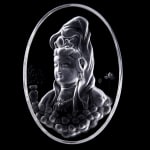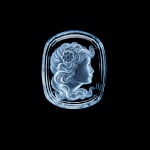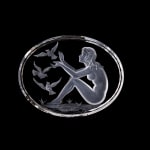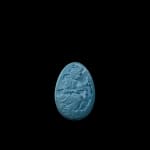

The Goddess of Mercy (Intaglio) by Wallace Chan (Sulptures & Carvings)

The Wallace Cut (invented in 1987) by Wallace Chan (Sulptures & Carvings)

Portrait of a Lady (Intaglio) by Wallace Chan (Sulptures & Carvings)

Lady and Birds (Intaglio) by Wallace Chan (Sulptures & Carvings)

The Birth of Love (Cameo) by Wallace Chan (Sulptures & Carvings)
The Enlightenment Period (1980s - 1990s)
Further images
The Enlightenment (1980s - 1990s)
In the 1980s, Chan first learnt of Italian master sculptor Michelangelo and his works. He was enchanted by the light and shadow, anatomy, tension and drama in the sculptures, which were uncommon in traditional Chinese art. He could not afford to go abroad to study the master’s sculptures, but he visited the Western cemeteries in Hong Kong, where he observed and learnt from the statues of angels and saints.
He became interested in the art and culture of the West. In addition to Chinese folklore, he began reading Greek mythology and Western fairy tales, which later inspired many of his works.
Chan was also encouraged by his clients to create cameos, which were hugely popular in Japan at the time. His model for the technique was Hong Kong’s one-dollar coin, which had a cameo of Queen Elizabeth II on one side.
By then, Chan had been exposed to a variety of gemstones, which came in a range of textures and colors and levels of transparency, from opaque to transparent, which led Chan to a dialogue with light through the body of his materials. He also trained himself to create intaglios.
By 1987, after two years of painstaking research and practice, including six months as an engineering apprentice in a factory, Chan invented The Wallace Cut, which is an illusionary carving technique that combines faceting and 3D internal carving. This breakthrough led to his first solo exhibition in the Gemstone Museum in Idar-Oberstein, Germany, where he was celebrated as a carving prodigy from Asia.
Thirty years later, the technique for creating The Wallace Cut remains a mystery to many.
First image: Buddha (Cameo) by Wallace Chan (Sulptures & Carvings)
Join our mailing list
* denotes required fields
We will process the personal data you have supplied to communicate with you in accordance with our Privacy Policy. You can unsubscribe or change your preferences at any time by clicking the link in our emails.





